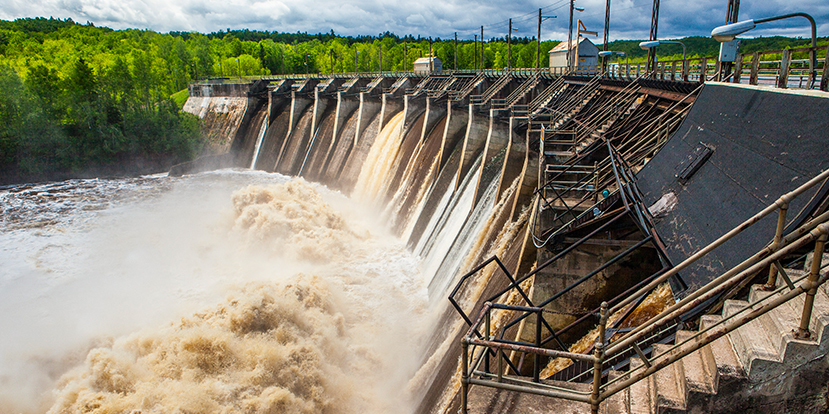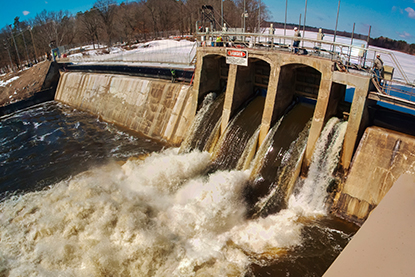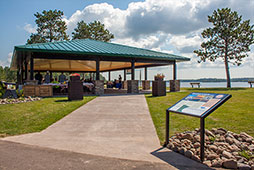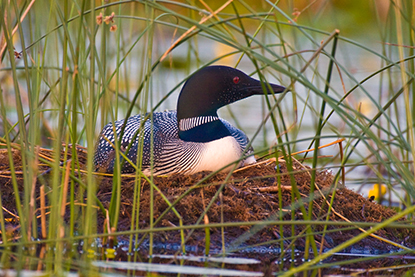
Generating hydroelectricity at 11 locations
Minnesota Power is well acquainted with the power of water. It’s the clean, renewable fuel we use to generate as much as 120 megawatts of electricity, making our hydroelectric system the largest producer of hydroelectricity in Minnesota.
We operate 11 hydro stations on five rivers with power production capacity ranging from a little more than 1 megawatt at Prairie River in Itasca County to 72 megawatts at Thomson in Carlton County. The hydro stations are spread out among three main river systems in central and northern Minnesota:
Northern Hydro includes Prairie River north of Grand Rapids and Winton near Ely on the Kawishiwi River, which drains north into the Rainy River and eventually into Hudson Bay. The Grand Rapids hydro station on the Mississippi River in Grand Rapids operates separately from the other hydro stations. It’s located at the Blandin paper mill and its two hydro units generate about 2 megawatts of power to supplement the paper plant’s electrical needs.
Western Hydro is in central Minnesota in the area of Brainerd and Little Falls along the Mississippi River. It includes the Little Falls, Blanchard, Pillager and Sylvan hydro stations.
Central Hydro is perhaps the most well-known part of Minnesota Power’s hydroelectric system. Located on the St. Louis River near where it flows into Lake Superior, Central Hydro includes stations at Knife Falls, Scanlon, Fond du Lac and Thomson, the largest hydroelectric facility in Minnesota. Unlike Western Hydro where the terrain is relatively flat, Central Hydro has more dramatic changes in elevation. The steeper terrain means significant rain events peak more quickly here.
 The Fond du Lac Dam is one of our four hydroelectric facilities on the St. Louis River and the last one before the river empties into Lake Superior.
The Fond du Lac Dam is one of our four hydroelectric facilities on the St. Louis River and the last one before the river empties into Lake Superior. Minnesota Power operates its stations and reservoirs under eight federal licenses. The Federal Energy Regulatory Commission, commonly known as FERC, oversees dam operations and safety in the United States, and FERC licenses specify operating parameters.
Hydro operators must balance the requirements of the FERC licenses with the whims of nature to maintain healthy river systems and keep the facilities running smoothly. River flow, elevation levels and other parameters are different for each facility. It’s both art and science to adapt to the seasonal variations of the rivers, daily changes in weather conditions and fluctuations in the amount of electricity that must be supplied to the power grid—all while complying with FERC regulations.
While the hydro operators can open and close many gates at the dams remotely, others have to be adjusted manually. Minnesota Power maintains crews in the three hydro divisions for operations and maintenance.

Except for Thomson, all of Minnesota Power’s hydro stations are run of river. These stations don't store water in reservoirs and instead rely on the natural flow rate of the rivers to generate electrity. As water flows downstream, some of it is diverted through turbines in a powerhouse and then is immediately released back into the river.
Think of the area behind one of these run-of-river dams as a bucket or pitcher. Water fills the bucket from one side at the same time water pours out the other side. Gates on the dams allow operators to manage the “bucket” so the water level remains fairly constant at the dam itself. For example, gates are opened to let more water pass through when storms or snowmelt result in heavy runoff, but the actual water level at the dam doesn’t change appreciably.
Thomson, however, operates differently. A conventional reservoir behind Thomson Dam stores water for later use, allowing the power station to call on it for its turbines as needed. For example, the reservoir may be allowed to fill overnight when demand for electricity is low. In the morning, when demand on the electric grid normally increases, water is released from the reservoir and used to generate power.
 Sylvan Hydro, on the Crow Wing River west of Brainerd, Minn., celebrated its centennial in 2013.
Sylvan Hydro, on the Crow Wing River west of Brainerd, Minn., celebrated its centennial in 2013. Thomson is part of the St. Louis River Project, which also includes five storage reservoirs on the Whiteface, Cloquet and Beaver rivers that flow into the St. Louis River upstream from four Minnesota Power hydroelectric stations. These reservoirs—Whiteface, Boulder Lake, Island Lake, Fish Lake and Rice Lake—provide water for hydroelectric generation in the winter when there isn’t enough natural flow in the St. Louis River.
Minnesota Power releases water from the reservoirs in the winter and in spring, discharges are reduced, allowing the reservoir to fill again in preparation for the next winter’s controlled drawdown.
Winter or summer, the four hydro stations on the St. Louis River—Knife Falls, Scanlon, Thomson and Fond du Lac—make use of the same water four times before it finds its way to Lake Superior.
In northern Minnesota, Birch Lake Reservoir supplies water for winter generation at Winton Hydro on the Kawishiwi River, much like the reservoirs in the St. Louis River Project do for the hydro stations on the St. Louis River. Minnesota Power doesn’t own or operate any storage reservoirs in our Western Hydro division.
Facilities operate under FERC licenses
 Relicensing for our facilities will be completed in phases between 2017 and 2044. (Click image to view larger.)
Relicensing for our facilities will be completed in phases between 2017 and 2044. (Click image to view larger.) Minnesota Power operates 11 hydroelectric facilities on five rivers in central and northeastern Minnesota. The facilities are operated under eight licenses from the Federal Energy Regulatory Commission.
The licenses permit Minnesota Power to use public waters for energy generation and outline the conditions for hydroelectric plant operations and mitigation of potential environmental impacts. Federal licenses authorize the operation of hydroelectric plants for 30 to 50 years.
In 2017, Minnesota Power began the relicensing process for two of its facilities, the Grand Rapids Hydroelectric Project and the Prairie River Hydroelectric Project. Relicensing for all of our facilities is staggered across the next quarter-century, ending in 2044.
Minnesota Power is following FERC’s Integrated Licensing Process for Grand Rapids and Prairie River. The process takes about seven years and includes scoping documents; studies; consultation with resource agencies, tribes, non-governmental organizations and other stakeholders; and FERC review and analysis before a new license is issued.
Stay informed
You can learn more about how hydroelectric projects are licensed at www.ferc.gov and how you can get involved. To receive notifications when new documents are filed into the relicensing record, register an account with FERC and sign up for its eSubscription service. You also can submit comments to FERC using the eComment service. Learn more here.
Your guide to electronic information at FERC.
For more information, including meeting notes, study plans and other documents required for relicensing as the process unfolds, please visit https://www.mnpower.com/Environment/Hydro
Places to play, protect and preserve
Minnesota Power’s commitment to hydroelectric power includes environmental stewardship in the watersheds where we have facilities and providing a variety of public recreational opportunities. It’s part of how we pay the public back for the use of its water and fulfill our Federal Energy Regulatory Commission hydroelectric licenses.
Some of the most visible aspects of hydropower management are Minnesota Power’s 17 reservoirs near Royalton, Little Falls, Pillager, Brainerd, Grand Rapids, Duluth and Ely. The land surrounding our reservoirs is managed by our land and real estate management staff for public recreation, forest and wildlife stewardship, cultural and historical site protection, environmental education and lakeshore cabin and home sites offered through a long-term leasing program, called Shoreland Traditions.
 Island Lake Reservoir is a popular place for boating and other outdoors activities.
Island Lake Reservoir is a popular place for boating and other outdoors activities. Beginning in 1995, Minnesota Power set aside about 6,000 acres of waterfront property from development on its reservoirs near Duluth. These lands, known as Natural Character Areas, serve multiple uses, including wildlife habitat enhancement, public recreation and forest management.
Five reservoirs – Whiteface, Boulder Lake, Island Lake, Fish Lake and Rice Lake – are part of the St. Louis River Hydroelectric Project. These reservoirs help provide water downstream for hydroelectric generation in the winter when there isn’t enough natural flow in the St. Louis River. Minnesota Power releases water from the reservoirs in the winter; in spring, discharges are reduced to allow the reservoir to fill again in preparation for the next winter’s controlled drawdown. Birch Lake Reservoir operates in a similar fashion for the Winton Hydro Station.
Outdoor activities such as boating, swimming, hunting, hiking, camping and skiing are a way of life in Minnesota. Most of Minnesota Power’s nonleased reservoir lands are open to the public, and we provide a variety of amenities such as boat launches, campsites, picnic areas and trails. Boulder Lake Reservoir and Island Lake Reservoir north of Duluth are two of our most popular recreation areas.
Land around the reservoirs also boasts many historical and cultural sites. Native Americans lived in the area for thousands of years before the arrival of the Europeans and rivers were long used as a means of travel and for commerce. Areas surrounding the reservoirs contain sites ranging from canoe portages used by early Native Americans to ox-cart trails used by European settlers to the boyhood summer home of aviator Charles Lindberg. Some, like the boyhood home of famed aviator Charles Lindberg located on the shores of the Company’s Zebulon Pike Reservoir near Little Falls, are open to the public. Others, such as Native American burial mounds, are protected.
In addition to historical and cultural sites, hundreds of artifacts including prehistoric spear points, knives, hand tools and ceramic pottery up to 10,000 years old, have been found on land surrounding the reservoirs. Minnesota Power’s cultural resource archaeologist has photographed and documented hundreds of these artifacts.
The Boulder Lake Management Area is a unique natural resource management education program developed in cooperation with the St. Louis County Land Department, Minnesota Department of Natural Resources and the University of Minnesota-Duluth’s Center for Environmental Education. Established in 1991, the BLMA contains more than 18,000 acres of land and water, including the 4,480-acre Boulder Lake Reservoir. It features the popular Boulder Lake cross-country ski trails, interpretive trails, public programs and formal environmental education activities, and is the site for the Boulder Lake Ski Race and the Sasquatch Scramble Obstacle 5K Trail Run. In 2013, Boulder Lake played host for the first time to a weekend of competitive trail riding organized by the Duluth Area Horse Trail Alliance.
Minnesota Power provides 18 water accessible primitive campsites and four group campsites on the reservoir. Anglers come to the reservoir for bluegill, perch, bass, crappie, walleye and northern pike.
At 10,800 acres, Island Lake Reservoir is the largest of the reservoirs near Duluth, and attracts boaters, anglers, swimmers and other outdoors enthusiasts. In recent years, visitors have found a series of improvements at the popular reservoir, including a bigger swimming beach, covered pavillion, safer parking and more barrier-free access.
 An informational display about Minnesota Power’s hydroelectric system was installed at Island Lake Reservoir.
An informational display about Minnesota Power’s hydroelectric system was installed at Island Lake Reservoir.
Island Lake Park’s more visitor-friendly beach is one of the most significant improvements at Island Lake Reservoir. The original 100-foot beach was lengthened to 300 feet and visitors no longer have to step down through rocks to get to the water. A large covered pavilion provides a comfortable place for enjoying a picnic.
Other upgrades at Island Lake Park included improved signage and marker buoys, and easy access from the parking lot to barrier-free picnic tables, benches and bathroom facilities.
Popular in all seasons, Island Lake Reservoir is the site for a variety of events including triathlons and fishing competitions. The Brewhouse Triathlon, the Buzz Ryan Sprint Triathlon and the ALS Walleye Tournament all take place here.
Minnesota Power provides 11 water accessible primitive campsites on the reservoir. Anglers here find bluegill, perch, bass, crappie, walleye, northern pike, and musky.
The 5,120-acre Fish Lake Reservoir is used to store water to supplement winter water flow for hydroelectric power generation on the St. Louis River. The reservoir attracts anglers for bluegill, perch, bass, crappie, walleye and northern pike. Minnesota Power, with the Minnesota DNR, provides public boat access and accessible shorefishing at the Fish Lake Reservoir Dam. We also work with the DNR and local resort businesses to provide other public boat launches. Minnesota Power provides eight water accessible primitive campsites on the reservoir.
The 2,590-acre Wild Rice Lake Reservoir is used for water storage to supplement water flow in the winter for generating hydroelectricity at our facilities on the St. Louis River. Anglers at Wild Rice Lake Reservoir find crappie, bluegill, perch, walleye and northern pike. Minnesota Power, with the Minnesota DNR, provides public boat access and accessible shorefishing at the reservoir dam. Because of the challenging shoreline, Minnesota Power is able to provide only one water accessible primitive campsites on the reservoir.
The 5,440-acre Whiteface Reservoir is used to store water for supplementing winter water flow used for hydroelectric power generation on the St. Louis River. Whiteface attracts anglers for crappie, perch, walleye and northern pike. Minnesota Power provides public boat access at the Whiteface Reservoir Dam, and works with the Minnesota DNR and local resort businesses in providing other public boat launches. We cooperate with the U.S. Forest Service at the agency’s Whiteface Reservoir Campground on the north end of the reservoir.
The 419-acre Knife Falls Reservoir was developed for hydroelectric power generation on the St. Louis River in Cloquet, Minnesota. The reservoir attracts anglers for bass, catfish, walleye and northern pike. Minnesota Power provides shorefishing along the north shore of the reservoir and the city of Cloquet provides boat access near its municipal campground.
The 81-acre Scanlon Reservoir was developed for hydroelectric power generation on the St. Louis River in Scanlon, Minnesota. The reservoir is not available for public use; however, downstream of the reservoir is Minnesota Power’s Scanlon Riverside Park, providing accessible shorefishing and whitewater kayaking and rafting access to the St. Louis River. Minnesota Power provides annually scheduled supplemental water flows for enhancing whitewater recreation during low water flow periods.
The 649-acre Thomson Reservoir was developed for hydroelectric power generation on the St. Louis River in Carlton, Minnesota. Minnesota Power, in cooperation with the UMD Outdoor Program, provides a whitewater take-out access for paddlers traveling downstream from Scanlon on the St. Louis River. Downstream of the Thomson Dam, MP’s property plays host to whitewater kayaking events. Minnesota Power provides annually scheduled supplemental water flows to enhance whitewater recreation.
The 185-acre Fond du Lac Reservoir was developed for hydroelectric power generation on the St. Louis River, surrounded by Jay Cooke State Park. Minnesota Power, in cooperation with Jay Cooke State Park, provides canoe carry-down access to the reservoir in the vicinity of the Grand Portage historic trail parking lot.
 A variety of wildlife, such as this loon, is found in the areas surrounding our hydro facilities.
A variety of wildlife, such as this loon, is found in the areas surrounding our hydro facilities.
The 5,600-acre Birch Lake Reservoir is used for water storage to supplement winter water flow used for hydroelectric power generation on the South Kawishiwi River at Winton, Minnesota. This reservoir attracts anglers for bass, perch, crappie, walleye and northern pike. Minnesota Power provides a Wayside Rest, shorefishing and primitive trail access to the South Kawishiwi River at the Birch Lake Dam, on State Highway 1. Resorts and houseboat businesses provide alternative access to the reservoir.
At the south end of the reservoir, the city of Babbitt, Minnesota, provides a recreation facility that includes a boat launch, swimming beach, and picnic facilities. Minnesota Power works with the U.S. Forest Service in providing public access at each of the agency’s two campgrounds. The Forest Service provides multiple water accessible primitive campsites on the reservoir. St. Louis County provides a public boat access on the southwestern end of the reservoir.
The 1,500-acre Garden Lake Reservoir (including Garden Lake, Farm Lake, South Farm and Friday Lake) was developed for hydroelectric power generation on the Kawishiwi River in Winton, Minnesota. Anglers come here for crappie, perch, bass, walleye and northern pike. Minnesota Power works with the Minnesota DNR to provide an accessible shorefishing site and public boat launch off the Fernberg Road, three miles east of Ely, Minnesota. Resort businesses provide alternative access to the reservoir. Minnesota Power works with the U.S. Forest Service to provide public access on the Farm Lake end of the reservoir. We also work with the DNR in providing a parking lot, trail and public viewing site on Minnesota Power land for access to the Kawishiwi Waterfalls, adjacent to the Winton Hydroelectric station, with beautiful views of Fall Lake.
The 1,300-acre Prairie Lake Reservoir was developed for hydroelectric power generation on the Prairie River near Grand Rapids, Minnesota. Here, anglers find crappie, bass, perch, walleye and northern pike. Minnesota Power provides an accessible public boat launch at the east end of the Prairie River Dam. Resort businesses provide alternative access to the reservoir. Itasca County maintains the beautiful Gunn Park, on the west shore of the reservoir, providing a pavilion, shorefishing, picnic facilities, and recreational fields.
The 1,400-acre Zebulon Pike Reservoir was developed for hydroelectric power generation on the Mississippi River near Royalton, Minnesota. This reservoir attracts anglers for catfish, crappie, walleye and northern pike. Minnesota Power provides an accessible shorefishing site downstream of the Blanchard Dam, a canoe portage around the dam, and a public boat launch to the reservoir. The reservoir possesses multiple historic and cultural sites, including the boyhood home of famed Minnesota aviator Charles Lindberg, now managed as Lindberg State Park. It also has a submerged outpost/fort used by Zebulon Pike while exploring the region. The Minnesota DNR provides an alternative public boat launch on the western shore of the reservoir in the vicinity of Lindberg State Park.
The 700-acre Little Falls Reservoir was developed for hydroelectric power generation on the Mississippi River at Little Falls, Minnesota. The popular reservoir attracts anglers for catfish, crappie, walleye and northern pike. Minnesota Power provides a canoe portage at the east shore of the dam. Minnesota Power donated land downstream of the Little Falls Dam for a city historic interpretation-recreation park, and cooperates with the city to provide a lakewalk and access at La Bourget Park on the reservoir.
The 800-acre Lake Placid was developed for hydroelectric power generation on the Crow Wing River in Pillager, Minnesota. Lake Placid attracts anglers for bass, perch, crappie, walleye and northern pike. Minnesota Power works with the town of Pillager to provide accessible shorefishing and a public boat launch off at the Pillager Dam. The Minnesota DNR provides a public access at Alvar’s Landing. Minnesota Power provides two water accessible primitive campsites on the reservoir.
The 2,000-acre Sylvan Reservoir (includes the Gull River Flowage) was developed for hydroelectric power generation on the Crow Wing River downstream of Pillager, Minnesota. Fish species found here include crappie, bass, perch, walleye and northern pike. Minnesota Power provides a boat launch and canoe portage downstream of the Sylvan Dam. We also work with the Minnesota DNR to provide an accessible shorefishing site and public boat launch off County Road 36. The DNR provides a public access at Wilder’s Landing, on the north shore of the reservoir.
The 473-acre Blandin Reservoir (also known as Paper Mill Reservoir) was developed for hydroelectric power generation on the Mississippi River in Grand Rapids, Minnesota. It attracts anglers looking for bass, perch, crappie, walleye and northern pike. A volunteer portage service is available to shuttle paddlers traveling this segment of the Missisissippi River and can be reached at 218-256-3871 for more information. The U.S. Corp of Engineers manages Pokegama Park on the most upstream portion of the reservoir, providing shorefishing, picnic facilities and camping. The Forest History Center is a unique education facility on the south shore of the reservoir offering the public a look at the history of the timber industry in Minnesota. The Grand Rapids Showboat is a vintage paddle boat stationed on the north shore of the reservoir during the summer and serves as the backdrop for scheduled evening entertainment variety shows. Blandin Corp. provides a public boat launch on the southwestern shore of the reservoir. The city of Grand Rapids also provides a public boat launch on the south shore of the reservoir.
Click here to view a map with all the recreation sites.
